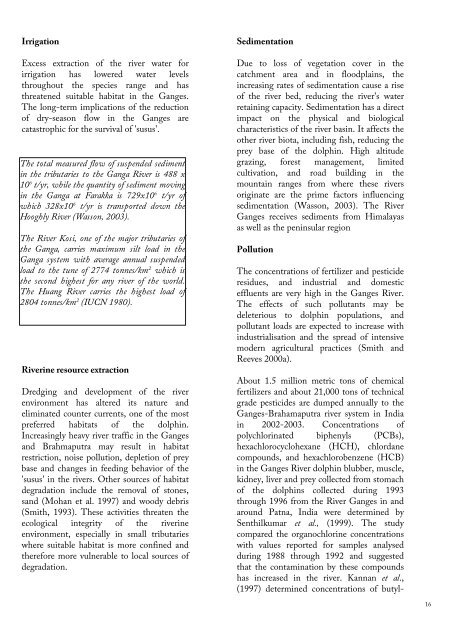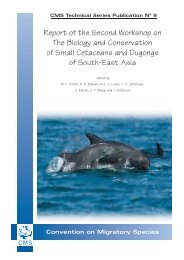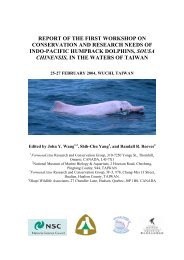the conservation action plan the ganges river dolphin - IUCN SSC ...
the conservation action plan the ganges river dolphin - IUCN SSC ...
the conservation action plan the ganges river dolphin - IUCN SSC ...
Create successful ePaper yourself
Turn your PDF publications into a flip-book with our unique Google optimized e-Paper software.
IrrigationExcess extr<strong>action</strong> of <strong>the</strong> <strong>river</strong> water forirrigation has lowered water levelsthroughout <strong>the</strong> species range and hasthreatened suitable habitat in <strong>the</strong> Ganges.The long-term implications of <strong>the</strong> reductionof dry-season flow in <strong>the</strong> Ganges arecatastrophic for <strong>the</strong> survival of 'susus'.The total measured flow of suspended sedimentin <strong>the</strong> tributaries to <strong>the</strong> Ganga River is 488 x10 6 t/yr, while <strong>the</strong> quantity of sediment movingin <strong>the</strong> Ganga at Farakka is 729x10 6 t/yr ofwhich 328x10 6 t/yr is transported down <strong>the</strong>Hooghly River (Wasson, 2003).The River Kosi, one of <strong>the</strong> major tributaries of<strong>the</strong> Ganga, carries maximum silt load in <strong>the</strong>Ganga system with average annual suspendedload to <strong>the</strong> tune of 2774 tonnes/km 2 which is<strong>the</strong> second highest for any <strong>river</strong> of <strong>the</strong> world.The Huang River carries <strong>the</strong> highest load of2804 tonnes/km 2 (<strong>IUCN</strong> 1980).Riverine resource extr<strong>action</strong>Dredging and development of <strong>the</strong> <strong>river</strong>environment has altered its nature andeliminated counter currents, one of <strong>the</strong> mostpreferred habitats of <strong>the</strong> <strong>dolphin</strong>.Increasingly heavy <strong>river</strong> traffic in <strong>the</strong> Gangesand Brahmaputra may result in habitatrestriction, noise pollution, depletion of preybase and changes in feeding behavior of <strong>the</strong>'susus' in <strong>the</strong> <strong>river</strong>s. O<strong>the</strong>r sources of habitatdegradation include <strong>the</strong> removal of stones,sand (Mohan et al. 1997) and woody debris(Smith, 1993). These activities threaten <strong>the</strong>ecological integrity of <strong>the</strong> <strong>river</strong>ineenvironment, especially in small tributarieswhere suitable habitat is more confined and<strong>the</strong>refore more vulnerable to local sources ofdegradation.SedimentationDue to loss of vegetation cover in <strong>the</strong>catchment area and in floodplains, <strong>the</strong>increasing rates of sedimentation cause a riseof <strong>the</strong> <strong>river</strong> bed, reducing <strong>the</strong> <strong>river</strong>'s waterretaining capacity. Sedimentation has a directimpact on <strong>the</strong> physical and biologicalcharacteristics of <strong>the</strong> <strong>river</strong> basin. It affects <strong>the</strong>o<strong>the</strong>r <strong>river</strong> biota, including fish, reducing <strong>the</strong>prey base of <strong>the</strong> <strong>dolphin</strong>. High altitudegrazing, forest management, limitedcultivation, and road building in <strong>the</strong>mountain ranges from where <strong>the</strong>se <strong>river</strong>soriginate are <strong>the</strong> prime factors influencingsedimentation (Wasson, 2003). The RiverGanges receives sediments from Himalayasas well as <strong>the</strong> peninsular regionPollutionThe concentrations of fertilizer and pesticideresidues, and industrial and domesticeffluents are very high in <strong>the</strong> Ganges River.The effects of such pollutants may bedeleterious to <strong>dolphin</strong> populations, andpollutant loads are expected to increase withindustrialisation and <strong>the</strong> spread of intensivemodern agricultural practices (Smith andReeves 2000a).About 1.5 million metric tons of chemicalfertilizers and about 21,000 tons of technicalgrade pesticides are dumped annually to <strong>the</strong>Ganges-Brahamaputra <strong>river</strong> system in Indiain 2002-2003. Concentrations ofpolychlorinated biphenyls (PCBs),hexachlorocyclohexane (HCH), chlordanecompounds, and hexachlorobenzene (HCB)in <strong>the</strong> Ganges River <strong>dolphin</strong> blubber, muscle,kidney, liver and prey collected from stomachof <strong>the</strong> <strong>dolphin</strong>s collected during 1993through 1996 from <strong>the</strong> River Ganges in andaround Patna, India were determined bySenthilkumar et al., (1999). The studycompared <strong>the</strong> organochlorine concentrationswith values reported for samples analysedduring 1988 through 1992 and suggestedthat <strong>the</strong> contamination by <strong>the</strong>se compoundshas increased in <strong>the</strong> <strong>river</strong>. Kannan et al.,(1997) determined concentrations of butyl-16





